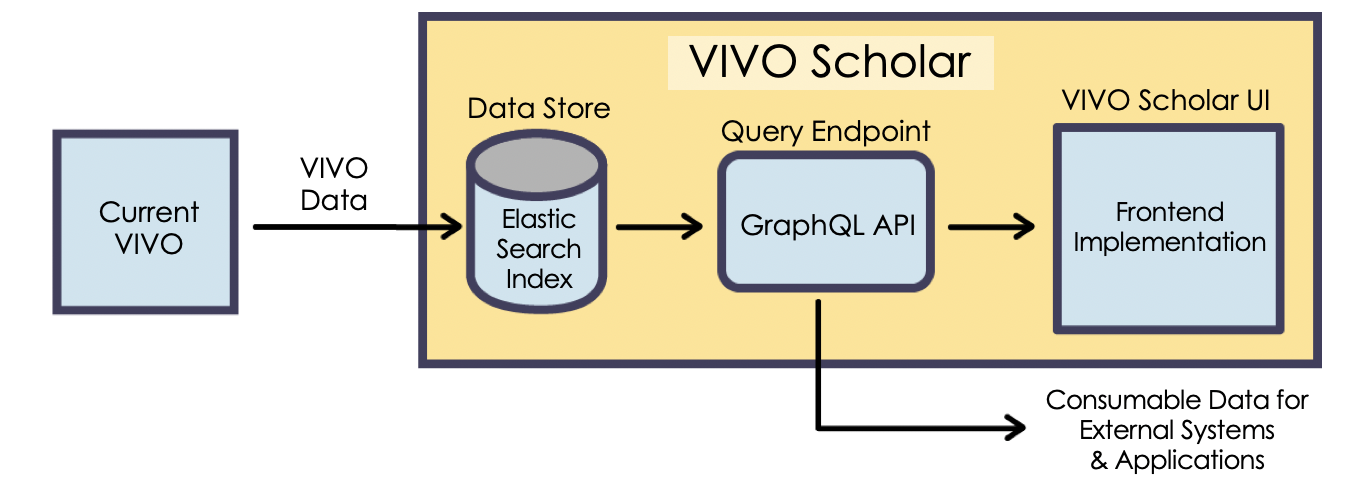This page is still under construction and the VIVO Scholar Task Force is still being formed.
The VIVO Scholar Task Force will be creating a new user interface for VIVO, called VIVO Scholar. VIVO Scholar will work with VIVO implementations at version 1.10 and above. The VIVO Scholar Task Force will begin on April 15, 2019.
The VIVO Scholar Task Force will address one of the goals in the Product Direction for 2019, "Modernize the Presentation Layer," which is a priority for many existing and prospective VIVO implementers. VIVO Scholar will build on the work of the Product Evolution Task Force, employing many of the ideas and technologies explored by that group. VIVO Scholar is also informed by the work of participants in the Architectural Fly-in Meeting held in January 2019.
Deliverables
VIVO Scholar will consist of three components:
- An ElasticSearch index which will contain all data from VIVO
- A GraphQL endpoint to provide an easy, developer-friendly mechanism for obtaining VIVO data (see video for interacting with GraphQL interface)
- The VIVO Scholar site, a read-only user interface that displays public profiles, provides a faceted search, and enables users to browse VIVO data
- The VIVO Scholar interface will conform with the Worldwide Web Consortium Content Accessibility Guidelines version 2.0, Level AA Conformance (WCAG 2.0 Level AA) https://www.w3.org/TR/WCAG20/
Benefits
VIVO Scholar is being designed to be:
- Fast–when loading pages and when retrieving VIVO data in near real-time
- Developer-friendly so it's easy to implement and customize
- Attractive and modern
- Responsive to many devices and accessible for users with disabilities
- Fully supportive of multiple languages
Existing VIVO implementations can:
- Add VIVO Scholar to their VIVO project and customize it to their institution OR
- Develop their own user interface using the data in the GraphQL endpoint
New VIVO implementations can:
- Install VIVO and VIVO Scholar, using VIVO to edit data and permissions OR
- Install VIVO and develop their own user interface using the GraphQL endpoint
Task Force Objectives
- The VIVO Scholar Task Force will consist of members from three or more institutions, but the majority will come from Duke University.
- Most of the members will have been involved with the Product Evolution Task Force in some way.
- We aim to keep the development team small, with 8 members or fewer if possible, and will include developers with applicable skills.
- Some developers may contribute for specific tasks or for specific sprints.
- The task force will operate with continuous, two-week sprints. Work will be deliverable-based rather than exploratory.
- Weekly meetings will be closed to keep discussions focused.
- We intend to streamline development processes and meetings as much as we can.
- We'll create milestones with deliverables that we can share with the community and get feedback
Facilitators
Damaris Murry, Duke University
Richard Outten, Duke University
Julia Trimmer, Duke University
Members
Robert Nelson, Duke University
Jim Wood, Duke University
Greg Burton, Duke University
Hans Harlacher, Duke University
Paul Albert, Weill Cornell Medicine
Sarbajit Dutta, Weill Cornell Medicine
Ralph O'Flinn, University of Alabama at Birmingham
Don Elsborg, CU Boulder
Alex Viggio, CU Boulder
Institutional Benefits of VIVO Scholar
Aside from being fast, modern, attractive, responsive, and easily-customized, VIVO Scholar offers an important component for institutions: the GraphQL endpoint.
The GraphQL endpoint works like VIVO widgets does for many institutions such as Duke; with GraphQL, developers can quickly and easily feed data to their own websites.
- At Duke, almost 85% of faculty have department profiles using VIVO data.
- Faculty and staff are very motivated to update their local websites, which updates VIVO.
- Widgets save web developers significant time by re-using data with little development effort.
- VIVO provides an institutional workflow for faculty to update their data in one place. "Update once, use everywhere."
- Using GraphQL, data is updated when VIVO is updated, nearly in real time.
Milestones
These are coming soon! Still TBD.
For Product Evolution milestones, see here.
More Information
Yep, we'll have meeting notes and all kinds of stuff here . . . soon.
